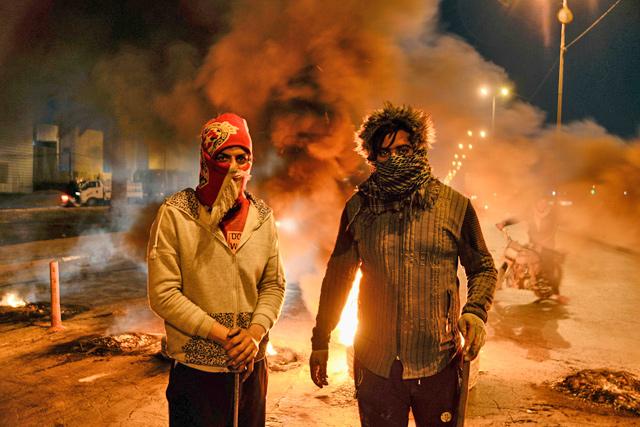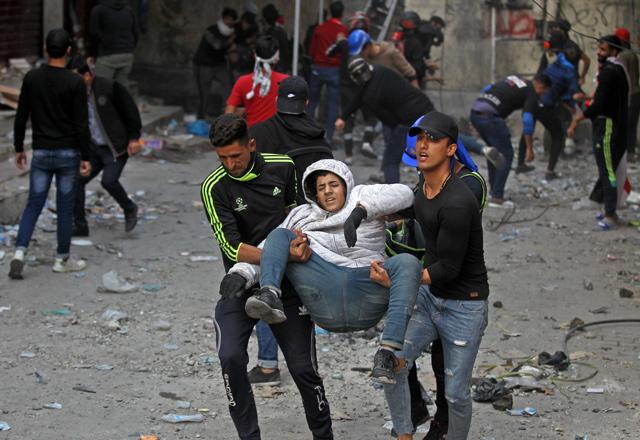You are here
Iraq unrest grows in two months of anti-regime protest
By AFP - Dec 19,2019 - Last updated at Dec 19,2019

An Iraqi demonstrator stands in front of a mural inspired by ongoing anti-government protests, in Tahrir Square in the capital Baghdad, on Thursday (AFP photo)
BAGHDAD — Anti-government demonstrations that erupted in Iraq on October 1 have escalated into its deadliest protest movement in decades, continuing unabated despite the government's resignation three weeks ago.
With President Barham Saleh under pressure to nominate a new prime minister by midnight Thursday, here is a recap of the unrest that has already claimed more than 460 lives.
Protests erupt
On October 1, hundreds of people gather in Baghdad and cities in the Shiite south in leaderless protests against corruption, unemployment and poor public services.
Riot police disperse about 1,000 protesters in the capital's Tahrir (Liberation) Square, including with live fire.
The first two demonstrators are killed, one in Baghdad and another in the south.
Protests continue into October 2, getting the backing of influential Shiite cleric Moqtada Sadr, who leads the biggest bloc in parliament.
Unrest spreads
On October 3, thousands defy a curfew in several cities, blockading streets and burning tyres.
Prime Minister Adel Abdel Mahdi defends his year-old government on television, asking for more time to implement reforms.
On October 4, clashes intensify and Sadr calls on the government to resign. Two days later the Cabinet announces reforms including in land distribution, social welfare and anti-corruption.
Deadly second wave
Protests resume on October 24, a day before the anniversary of Abdel Mahdi taking office.
Protesters in the south torch dozens of provincial government buildings and offices linked to the powerful Hashed Al Shaabi paramilitary force.
At least 63 people are killed over two days, according to the Iraqi Human Rights Commission.
On October 28, students, professors and schoolchildren join rallies in Baghdad and southern cities.
On October 31, the president raises the possibility of the prime minister's resignation.
Death toll mounts
On November 3, demonstrators in the central city of Karbala attack the Iranian consulate amid charges that Iran is propping up the government. Four are shot dead.
After a major strike and continuing demonstrations, on November 27 protesters torch the Iranian consulate in the holy city of Najaf.
The following day is one of the bloodiest in the uprising, with 46 protesters killed and 1,000 wounded across the country, including around two dozen in the southern city of Nasiriyah.
On November 29, demonstrators in Nasiriyah mob a police station and torch police cars. Another 15 protesters are killed.
PM resigns
Later on November 29, top Shiite cleric Grand Ayatollah Ali Sistani calls for a new government. Hours later Abdel Mahdi offers to resign.
Parliament accepts his departure on December 1 and formally tasks the president with naming a new candidate.
Talks to find a new prime minister intensify and include the commander of Iran's Revolutionary Guards, Major General Qasem Soleimani, a key ally of Iraq's main Shiite parties.
Washington denounces Tehran's "meddling".
Violence spirals
Late on December 6, armed men attack a Baghdad building where anti-government protesters had been camped out for weeks.
At least 20 protesters and four police officers are killed and about 80 demonstrators abducted, medical sources and witnesses say.
On December 7, a drone drops a bomb on Sadr's home in Najaf, damaging the exterior wall.
The following day a prominent civil society activist is shot dead in Karbala, while returning home from anti-government protests.
On December 12, two rockets are fired at a military base near Baghdad airport housing US troops, the latest in a series of such attacks that Washington blames on Iranian-backed groups.
Related Articles
BAGHDAD — Anti-government demonstrations that erupted in Iraq on October 1 have escalated into its deadliest protest movement in decades, wi
NASIRIYAH, Iraq — Anti-government protesters defied lockdowns and the threat of violence to demonstrate on Saturday in several Iraqi cities,
NASIRIYAH, Iraq — Iraqis kept up anti-government protests in Baghdad and the south on Saturday, dissatisfied with the premier's vow to quit














